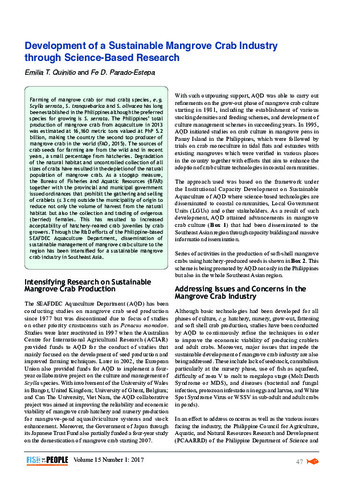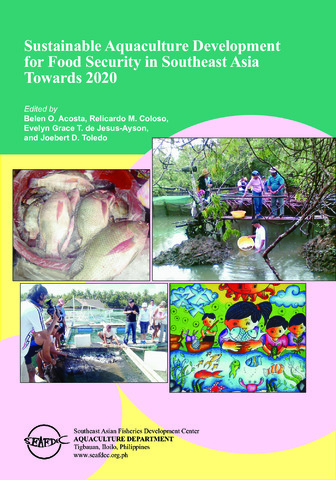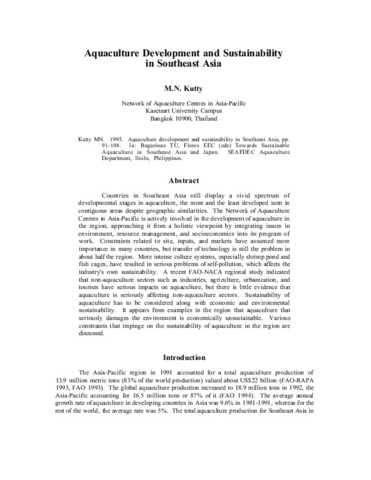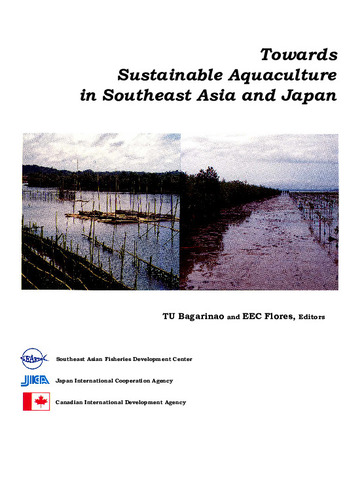បង្ហាញកំណត់ត្រាសាមញ្ញសម្រាប់ធាតុ
Development of a sustainable mangrove crab industry through science-based research
Share
| dc.contributor.author | Quinitio, Emilia T. | |
| dc.contributor.author | Parado-Estepa, Fe D. | |
| dc.date.accessioned | 2017-11-21T02:08:17Z | |
| dc.date.available | 2017-11-21T02:08:17Z | |
| dc.date.issued | 2017 | |
| dc.identifier.issn | 1685-6546 | |
| dc.identifier.uri | http://hdl.handle.net/20.500.12066/1008 | |
| dc.description.abstract | Farming of mangrove crab (or mud crab) species, e.g. Scylla serrata, S. tranquebarica and S. olivacea has long been established in the Philippines although the preferred species for growing is S. serrata. The Philippines’ total production of mangrove crab from aquaculture in 2013 was estimated at 16,160 metric tons valued at PhP 5.2 billion, making the country the second top producer of mangrove crab in the world (FAO, 2015). The sources of crab seeds for farming are from the wild and in recent years, a small percentage from hatcheries. Degradation of the natural habitat and uncontrolled collection of all sizes of crabs have resulted in the depletion of the natural population of mangrove crab. As a stopgap measure, the Bureau of Fisheries and Aquatic Resources (BFAR) together with the provincial and municipal government issued ordinances that prohibit the gathering and selling of crablets (≤3 cm) outside the municipality of origin to reduce not only the volume of harvest from the natural habitat but also the collection and trading of ovigerous (berried) females. This has resulted to increased acceptability of hatchery-reared crab juveniles by crab growers. Through the R&D efforts of the Philippine-based SEAFDEC Aquaculture Department, dissemination of sustainable management of mangrove crab culture to the region has been intensified for a sustainable mangrove crab industry in Southeast Asia. | en |
| dc.language.iso | en | en |
| dc.publisher | Secretariat, Southeast Asian Fisheries Development Center | en |
| dc.subject | Scylla serrata | |
| dc.subject | South East Asia | en |
| dc.subject | Philippines | en |
| dc.subject | hatcheries | en |
| dc.title | Development of a sustainable mangrove crab industry through science-based research | en |
| dc.type | magazineArticle | en |
| dc.citation.volume | 15 | |
| dc.citation.issue | 1 | |
| dc.citation.spage | 47 | |
| dc.citation.epage | 51 | |
| dc.citation.journalTitle | Fish for the People | en |
| dc.subject.asfa | aquaculture development | en |
| dc.subject.asfa | aquaculture economics | en |
| dc.subject.asfa | aquaculture regulations | en |
| dc.subject.asfa | brackishwater aquaculture | en |
| dc.subject.asfa | commercial species | en |
| dc.subject.asfa | crab culture | en |
| dc.subject.asfa | culture effects | en |
| dc.subject.asfa | cultured organisms | en |
| dc.subject.asfa | environmental degradation | en |
| dc.subject.asfa | fishery regulations | en |
| dc.subject.asfa | marine crustaceans | en |
| dc.subject.asfa | resource management | en |
| dc.subject.asfa | seed production | en |
| dc.subject.asfa | sustainable aquaculture | en |
| dc.subject.asfa | sustainability | en |




